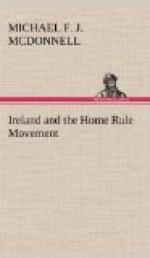The task proposed by Henry Grattan to the Irish Parliament may well be taken to heart by the Irish people to-day:—“In the arts that polish life, the manufactures that adorn it, you will for many years be inferior to some other parts of Europe, but to nurse a growing people, to mature a struggling, though hardy, community, to mould, to multiply, to consolidate, to inspire, and to exalt a young nation, be these your barbarous accomplishments.”
CHAPTER IV
THE LAND QUESTION
“I can imagine no fault attaching to any land system which does not attach to the Irish system. It has all the faults of a peasant proprietary, it has all the faults of feudal landlordism, it has all the faults incident to a system under which the landlords spend no money on their property, and under which a large part of the land is managed by a Court; it has all the faults incident to the fact that it is to the tenant’s interest to let his farm run out of cultivation as the term for revising the judicial rent approaches.”
—A.J.
BALFOUR, on the Second Reading of the Land Bill, May
4th, 1903.
The reason for the importance of the system of land tenure in the social conditions of Ireland is to be found in the manner in which the restrictions on Irish commerce in the seventeenth and eighteenth centuries drove the population to secure a livelihood in the only direction left open to them—namely, agriculture. The results of this are to be seen to-day in the fact that there are 590,000 holdings in the island, and that out of a total population of four and a half million people it is well within the mark to say that three and a half million are dependent, directly or indirectly, on the land for their means of existence.




